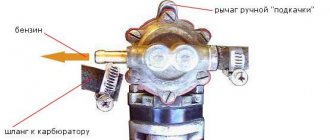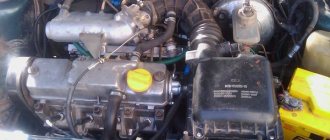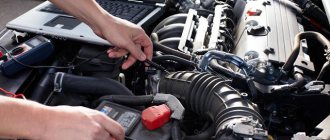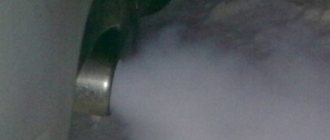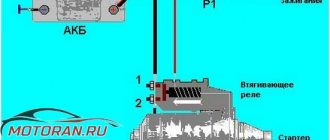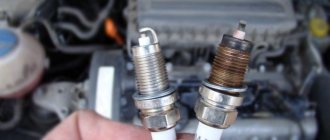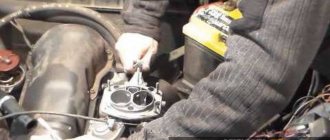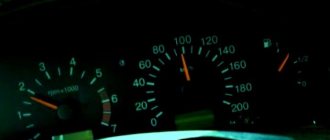Why does the Niva stall at idle (main reasons)
The Niva stalled immediately after starting, why?
Almost always, if a Niva car does not idle and stalls, the reason for this is contamination of parts, for example:
- The throttle valve, injector or carburetor is clogged.
- The idle relay has failed.
- The idle jets are dirty.
- The fuel pump is dirty.
- The engine ventilation system is clogged.
The car stalls after turning off the starter
A dirty throttle valve is to blame!
It happens that the car does not want to slow down the engine speed when you release the gas pedal or stalls at idle. Basically, the problem here lies in a clogged throttle valve. It might just jam.
This problem can happen if you constantly drive on low-quality gasoline. The damper can become clogged when contaminated air enters.
The problem can be corrected by cleaning the damper . To do this, you need to use a regular carburetor cleaner. It is sold in the store.
You should also pay attention to the clogging of the oil trap in the engine crankcase. In this case, the engine will suffocate from excess gases from the crankcase. As a result, it will not hold idle speed and stall. To eliminate the problem, you should regularly wash the crankcase ventilation filter.
The engine stalls immediately, but then starts
Idle speed regulator.
Here the reason may be in the firmware of the electronic engine control unit. The reason for this may be improperly performed tuning of the power unit. In this case, the engine will operate stably only at high speeds. If they drop below 1,000 rpm, the engine will simply stall. This malfunction can be eliminated by flashing the unit to the factory version of the program.
You should also pay attention to all kinds of sensors in car systems. These are, for example, the idle speed control, the throttle position sensor and others. They need to be checked at stands.
The carburetor is Niva’s problem
Inspection and disassembly of the carburetor.
If a carburetor , then in 4 cases out of 5 it can be the cause of unstable engine operation. The most common problem is that the carburetor is clogged. Although this unit is considered reliable in a car, it should also be cleaned periodically. It must be washed using special solvents that are sold in the store.
Carburetor contamination
The main enemy of the carburetor is low-quality fuel . Dirt and moisture can also get there from the tank. Therefore, it is recommended to regularly change the fuel filter, which is installed in front of the carburetor.
The fuel pump should be cleaned periodically. A mesh is installed on it, which traps debris.
Poor quality or old hoses through which fuel enters the tank are another reason for carburetor clogging. Such parts need to be changed every 10–15 years.
Fuel jet
It should be checked when the car stalls at idle. To check, you need to turn on the ignition and reset the wire from the EMC and reconnect it. A click should be heard. When it is not there, you should check whether voltage is supplied to it. In some cases, you will have to completely replace the part.
No compression
The most unpleasant reason is a decrease in compression in one of the cylinders.
This problem can only be identified and fixed in a professional workshop:
- valve burnout - the pressure decreases due to a leaky fit of the valve to the seat;
- failure of hydraulic compensators - when they jam, the valves can “hang”, which is why compression decreases;
- wear of the cylinder-piston group is determined by a special tool that measures the gap between the cylinder and piston rings.
The life of spark plugs is limited, so it is necessary to check their condition. After unscrewing all the spark plugs, you can detect if they are not working by inspection. A characteristic black soot will be visible on it, which covers the electrodes and subsequently interferes with the high-quality breakdown of the spark.
If replacing the spark plug does not help, then the engine may stall due to a faulty high-voltage wire.
Carburetor car engine starts and stalls
In this article we will take a closer look at the situation when a carburetor engine of a passenger car (VAZ 2108, 2109, 21099, 2105, 2107 and their modifications) starts and stalls due to a carburetor malfunction.
Malfunctions of carburetors 2105, 2107 Ozone, 2108, 21081, 21083 Solex and their modifications will be considered. — The engine starts, runs for a few seconds and stalls, repeated starts are unsuccessful.
— The engine starts with difficulty, after running for a short time it stalls, after restarting it starts and runs.
— The engine starts and immediately stalls, starts again and stalls again, and so on several times, but then it still starts working.
Causes of the malfunction “carburetor engine starts and stalls”
There is no fuel in the float chamber
Pump it up using the manual pump lever on the fuel pump.
The fuel pump or power system may be faulty. Remove the hose from the carburetor fuel supply fitting and press the manual primer lever on the fuel pump several times. A strong pulsating stream of gasoline should come out of the hose hole. If it is missing or weak, check the fuel pump or power system.
Checking the VAZ fuel pump
The strainer at the carburetor inlet is clogged
Remove it by unscrewing the cap, clean it (you can use a toothbrush), rinse with acetone or gasoline and blow with compressed air. At the same time, clean the filter seat in the carburetor cover.
Details of strainer filters for fuel purification of carburetors 2108, 21081, 21083 Solex, 2105, 2107 Ozone
The solenoid valve is faulty or the fuel jet of the idle system is clogged
Check whether the solenoid valve or the idle air system fuel nozzle holder has become loose due to any circumstances. Turn it on. Remove the wire from the valve and then put it back on. You should hear the click of the valve being activated. If it is not there, we connect a piece of wire plus the battery and the valve outlet. There is no click - we change the valve. There is a click - we check the EPH system.
Solenoid valves for carburetors 2108, 21081, 21083 Solex, 2105, 2107 Ozone
Check the serviceability of the valve itself by unscrewing it from the carburetor and removing the fuel jet from it. The jet should be carefully inspected for contamination and deformation. We also check the ease of movement of the valve shut-off needle, the presence and integrity of the rubber O-ring on the valve body.
Carburetor solenoid valve design
Unscrew the idle air system fuel nozzle holder (on carburetors with a holder instead of a solenoid valve), rinse, clean the fuel nozzle and blow with compressed air.
“Suction” of foreign air into the carburetor
In this case, the fuel mixture is lean. If the engine starts and immediately stalls, it is most likely very lean. The image shows probable places where foreign air is “sucked in” on the 2108 Solex carburetor.
Places of possible “suction” of foreign air into the carburetor 2108, 21081, 21083 Solex
Read more about the “suction” of foreign air in the article “Suction of foreign air into the carburetor.”
Trigger diaphragm damaged or out of adjustment
Disassemble the starter housing and replace the diaphragm with a new one. Adjust the starting device.
Starting devices for carburetors 2108, 21081. 21083 Solex, 2105, 2107 Ozone
Fuel and air jets, emulsion wells and tubes of the main dosing system are clogged
It is necessary to remove the carburetor cover, unscrew the jets, remove the tubes, rinse and clean them, clean the wells, blow everything out with compressed air and put it back. The image shows what should be cleaned on the carburetor 2105, 2107 Ozone.
On the Solex carburetor, unscrew the air jets and take them out along with the emulsion tubes. At the bottom of the opened wells there are fuel jets. We turn them out with a thin long slotted screwdriver. Clean, rinse with acetone and blow with compressed air.
Fuel and air jets, emulsion tubes and emulsion wells of GDS carburetors 2108, 21081, 21083 Solex, 2105, 2107 Ozone
Fuel and air jets and idle system channels are clogged
Unscrew the jets, rinse and clean them, and blow them with compressed air.
Air and fuel jets for CXX carburetors 2108 Solex and 2105, 2107 Ozone
You can try to clean the idle system without disassembling the carburetor. Here is an article on this topic “Cleaning the idle system of the carburetor 2108, 21081, 21083 Solex.”
The fuel level in the carburetor float chamber is broken
The fuel mixture is either very lean or very rich due to incorrect adjustment.
Approximate fuel level in the float chambers of carburetors 2108, 21081, 21083 Solex, 2105, 2107 Ozone
Articles on the site about adjusting the fuel level:
The carburetor air damper drive is not adjusted (“choke”)
A not fully open air damper causes the fuel mixture to become richer in some cases to such an extent that it is difficult to start the engine, especially when it is hot. The spark plugs may become flooded with fuel. Adjust the drive:
With the choke handle fully extended, the air damper should completely cover the cross-section of the first chamber of the carburetor.
The air dampers of carburetors 2108, 21081, 21083 Solex, 2105, 2107 Ozone are completely closed
With the handle fully recessed, the air damper should be strictly vertical.
The air dampers of carburetors 2108, 21081, 21083 Solex, 2105, 2107 Ozone are completely open
Notes and additions
— Before searching for the reasons that a carburetor engine starts and stalls, it is recommended to check the serviceability of the ignition system, since the symptoms of its malfunction are similar to the symptoms of a malfunction of the ignition system and the presence of fuel supply through the power system.
More articles on the site on carburetor malfunctions
Troubleshooting the fuel system
First of all, you should make sure that the fuel pump is working. When you turn on the ignition, a humming sound should be heard from under the rear seat for a while (within a few seconds). It would be a good idea to measure the pressure in the fuel rail. A special fitting is provided for this. Low pressure may be due to a malfunction of the regulator located in the pump block. Usually this block is changed entirely.
The fuel filter is changed according to regulations. It should be replaced at the first suspicion. Even if it turns out not to be the problem, you still need to change the filter.
With injectors the situation is more complicated. They are checked at a special stand. But injectors often cause difficult starting, and they can become clogged all at once. Typically, if an injector is faulty, the check engine light will come on. Faulty injectors must be replaced.
Source
Engine stalls without choke, stalls when cold
- Go to page:
Engine stalls without choke, stalls when cold
Post by bregovich » Nov 20, 2010, 11:54 pm
Re: Engine stalls without choke
Post by Ghost_killer » Nov 20, 2010, 11:58 pm
Re: Engine stalls without choke
Post by WhiteUnicorn » 21 Nov 2010, 01:20
Re: Engine stalls without choke
Post by Portada » 21 Nov 2010, 19:00
Re: Engine stalls without choke
Post by bregovich » Nov 21, 2010, 11:23 pm
Re: Engine stalls without choke
Post by Portada » Nov 21, 2010, 11:47 pm
Re: Engine stalls without choke
Post by WhiteUnicorn » 22 Nov 2010, 00:22
Re: Engine stalls without choke
Post by Portada » 22 Nov 2010, 00:25
Re: Engine stalls without choke
Post by ALK » 22 Nov 2010, 00:35
Who knows what's going on behind the fence of the zoo? ©
Re: Engine stalls without choke
Post by Egorych 31 » 29 Nov 2010, 23:06
Re: Engine stalls without choke
Post by ALK » Nov 29, 2010, 11:39 pm
heating from the exhaust manifold?? theoretically - yes, the air mass has become larger.
did the EPHH valve, as written above, change?? Does it also stall when you let off the gas?
Who knows what's going on behind the fence of the zoo? ©
Re: Engine stalls without choke
Post by Portada » Nov 29, 2010, 11:40 pm
Re: Engine stalls without choke
Post by Pasha » November 30, 2010, 10:48 am
Egorych 31
I have the exact same story. It started last winter - the carb was blowing, I adjusted the idle, but it didn't work. then I covered the radiator completely with cardboard and everything was fine
Now I want to try to install an electric fan, but I don’t have the money yet, and the cold weather is approaching.
And even in the summer, in traffic jams when the temperature rises above 90, the XX also starts to float and stalls
Re: Engine stalls without choke
Post by Egorych 31 » 30 Nov 2010, 21:58
Pasha I didn’t understand anything. Why is there a cardboard, the car doesn’t freeze, it’s warm in the cabin, the antifreeze temperature is 90. If I put the cardboard in, it might start to warm up, why do I need the cardboard? here is the corrugation - yes, it may be needed in winter for the carb, it may be cold.
Chew it on me, I haven’t had a Lada for a long time
Electrical faults
There are quite a lot of components of electrical equipment for a Chevrolet Niva car. Sometimes, in order to find the cause of a breakdown, you have to check all the components one by one. However, the experience of car enthusiasts allows us to identify the most vulnerable elements that cause the malfunction.
- The battery is low. It may fail due to long service life.
- Starter malfunction.
- Lack of contact at the battery terminals.
- Lack of spark (malfunction of spark plugs, power wires, ignition module).
- Fuse blown.
- Ignition switch malfunction.
- Errors in the immobilizer operation.
The car sometimes stalls at idle, carb
- Thank you
- I do not like
KuDeSNIK March 10, 2008
Carburetor engine, 1.8 l, carburetor costs 73rd. At times the car idles perfectly, and at times it stalls, but not immediately, but when it drops the revs to 500 rpm and makes a couple of revolutions, it stalls. The manifestation of the defect does not depend on the engine temperature. What has been done: 1. The distributor has been replaced (contactless system), the ignition has been adjusted (even with a strobe light). The high-voltage wires were ringed and checked “in a circle” by replacing them with a serviceable one from another set. The spark is normal. 2. The valves have been adjusted. 3. The carb was removed, purged and inspected. There is no large output, the membranes (acceleration and power modes) have been replaced with new ones (although there was no particular need). The throttle valves close normally (this was the case initially: the main other valve “sharpened” a ledge that prevented free full closing, this was eliminated by inserting a washer, which removed the backlash and the valve closes normally, the “clearance” gaps are normal). It holds idle (no defects appear) even with the screw for adjusting the mixture quality fully tightened (who knows: in this carb it only blocks the additional groove; gasoline still flows through the main one, i.e. fully tightening the screw does not mean completely shutting off the fuel supply) . 4. The solenoid valve with the jet was replaced (for some reason the jet was marked 39, now it’s 41). The valve clicks, the electronics are tested according to the procedure. It was also tested with a jumper 4-6 pins in the connector, i.e. Constantly forcing the fuel supply through this very valve did not help. 5. It was discovered that when the tube to the vacuum brake booster is closed, the defect disappears! The brake hose and vacuum booster were replaced (with new ones). 6. The afterburning or officially “recirculation” system is completely turned off and turned off (this is a gadget about which they say that it still doesn’t work properly, everyone turns it off). This is what connects the exhaust and intake manifolds. At the same time, it was checked whether the elements of the system hold a vacuum - they do. 7. Linings under the carb without signs of leakage, in good condition.
Observations: as I wrote, the manifestation of a defect does not depend on the engine temperature. Perhaps only from using the brake. Immediately after releasing the brake pedal, the engine makes a short-term increase in revolutions by 100-200. Sometimes, after several presses of the brake pedal (and, accordingly, jumps in revolutions), the defect disappeared and the revolutions were set to even (about 1000, well, how high it was). Also, when the defect appeared when accelerating (and at the same time the engine works great - it pulls, doesn’t sneeze), there was a “strumming” as if it was too advanced.
Need advice: what ELSE should you see? Very similar to “vacuum” problems, since it affects the ignition timing, but where? All “white tubes” are normal.
Ignition
The ignition module is a unit that comes into question after all the checks have been carried out. It is the bobbin that can become the culprit for the power unit tripping at idle or in other modes. To check the coil you need to do this:
Unscrew the spark plug, then apply it to the ground (any part of the body).
If the spark is good, its color is of high quality, and a characteristic crackling sound is heard, then the serviceability of the reel is not questioned. On the contrary, if there is no spark, or it is of poor quality, the module must be replaced, and thus it will be possible to “cure” the tripping.
It's not very often that a switch goes bad, but it does happen. It must be checked and, if anything, replaced.
Auto parts for foreign cars, auto repair
You can check it by installing a working relay. You can determine the lack of contact on the main components of car parts by visual inspection. It is necessary to tighten the contacts on the starter, the injector power supply and the fuel pump. The positive wire that powers the electronic injection system comes directly from the battery terminal with a separate wire. Often the problem with the immobilizer can be a low battery. You just need to install a new battery.
This is to clarify the Chevrolet Niva is difficult to start when cold due to a fault in the electrical part of the car, but do not forget about mechanical damage: The indicator on the instrument panel will help you find out if there is no fuel in the tank.
If the fuel gauge is at zero and the warning light in the form of a gas pump is on, then the source of the trouble has been detected and there is no need to open the hood. You can determine if a filter or fuel pump is faulty by hearing.
If you hear a loud buzzing sound in the rear trunk area, the filter or pump is most likely clogged, preventing fuel from getting to the engine. It indicates any damage to the injector or engine error. If the oil level in the car has dropped, this can be determined visually using a warning lamp in the form of a can on the instrument panel. If your Chevrolet Niva doesn't start well when it's cold, make sure there is enough oil in the engine, pull out the level meter and check.
Troubleshooting Having identified the problem that causes the Chevrolet Niva engine to start poorly, you can begin to fix the problem. Knowing the source of the problem, you can draw the appropriate conclusions: Most of the above reasons have a simple nature of damage, and fixing a Chevrolet Niva that doesn’t start well when cold won’t take much time.
A list of the main malfunctions when the engine does not start or starts poorly, and how to eliminate them. You can light a cigarette from another car, then the generator will recharge the battery. Clean the contacts if they are oxidized and lubricate them with Lithol. The lubricant prevents the appearance of oxide on the terminals. Tighten the terminals well to get good contact. Starter Check the starter contacts and tighten them.
In the case of a Chevrolet Niva, it is difficult to start when cold, have the starter repaired to rewind the windings, or install a new one.
Spark plugs Replace all 4 spark plugs with new ones, or clean them with sandpaper. But in any case, if the spark plugs have worked out, they need to be changed so that there are no problems with the engine.
Refuel only at branded gas stations, and only with fuel that is suitable for this type of engine A Fuses Install new fuses.
View topic
On a working engine control system it is equal to 7 degrees. Now we need to understand what leads to changes in SOP?
In the first case, there was an air leak, which I discovered using a Leak Check fog machine. Malfunctions along the way Updated It is necessary to find the malfunction and, if possible, eliminate it.
Start the engine and let it idle. Go to the exhaust pipe and listen to the sound of the exhaust.
You can bring your hand to the cut of the exhaust pipe - this way the interruptions are felt better.
How to check the fuel system?
The fuel system contains many elements and parts that can stop working at any time. Some nodes cannot cope with high loads. At this moment the car stalls when you press the gas. The engine stops working due to a small amount of fuel in the combustion chamber. In this case, it is recommended to check the fuel pump. This is done using a pressure gauge and supplying power to the pump. If the fuel pump is working properly, the pressure gauge will show a figure equal to 2.7 atmospheres. Slight deviations in one direction or the other are allowed. If the number is significantly lower, then the problem is a faulty pump - it needs to be replaced. For domestic cars it is inexpensive - about 1 thousand rubles.
When the car stalls when you sharply press the gas, this is one of the most possible reasons. Malfunctions often occur in the injectors - they spray a combustible mixture into the engine cylinders. They can fail due to the quality of the fuel. Low-quality gasoline contains impurities that pass through the filter. They clog the injector nozzles. It will not be possible to test the injectors in a garage; you need a special stand.
You can try to perform independent diagnostics, but for this the injector must really be broken. For the test, unscrew the fuel rail. The nozzles are retracted to the other side of the engine, and then the starter is fired. In this case, the fuel must be atomized - if gasoline flows or drips, the injectors must be changed. A poor level of atomization can also lead to problems when the car stalls when you press the gas.
